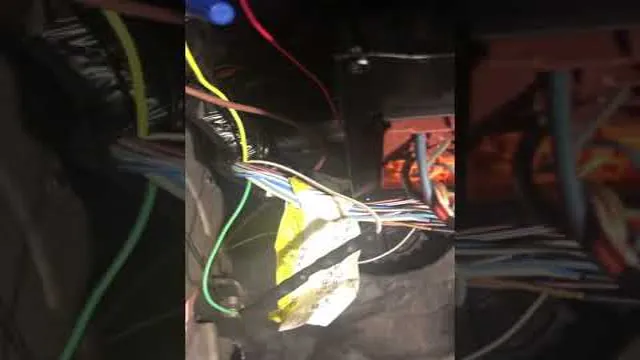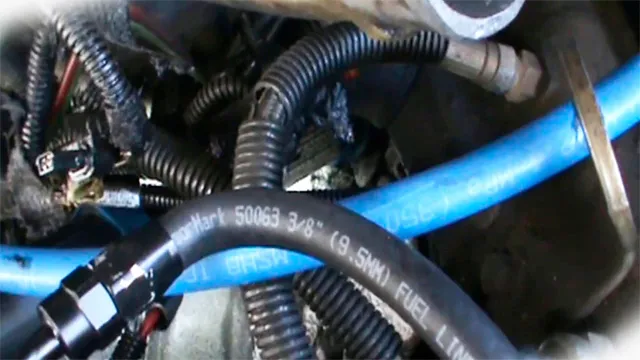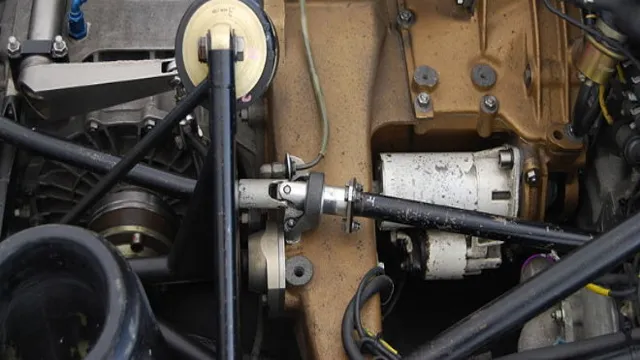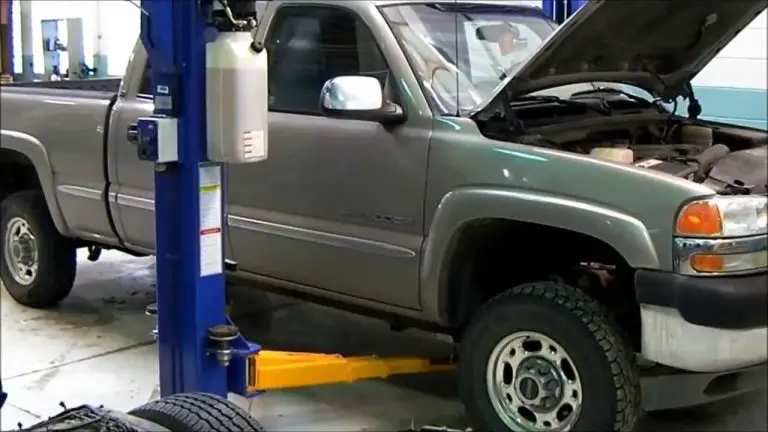Mastering the Art of Balance: A Step-by-Step Guide on How to Balance Your Drive Shaft
Have you ever experienced that dreaded vibration while driving your car? It could be a sign that your drive shaft is out of balance. A drive shaft plays a fundamental role in the power and performance of your vehicle. It connects your engine to the rear axle and transmits the power, causing the wheels to move together.
However, if the drive shaft is unbalanced, it can cause significant damage to your car’s suspension, tires, and transmission. Fortunately, balancing the drive shaft is not difficult or overly expensive, but it requires some know-how and specialized equipment. Your drive shaft must be balanced using a device specifically designed for this purpose.
This machine rotates the drive shaft and measures how much it vibrates. Once the technician has determined where the imbalance is located, they can precisely add weight to the drive shaft to counterbalance it. If you’re experiencing vibration while driving, don’t ignore it.
An unbalanced drive shaft can cause severe problems if left unresolved. Not only will it affect your vehicle’s performance, but it will also cause undue wear and tear on various parts, leading to even more repair expenses in the long run. By balancing your drive shaft, you’ll be ensuring the smooth operation of your vehicle and extending its lifespan.
Don’t hesitate to have it checked out by a professional technician to avoid any further issues.
Understanding Imbalance
If you’re experiencing vibration or noise from your car or truck’s drivetrain, it could indicate an imbalance in your drive shaft. An imbalanced drive shaft can cause driveline vibration, uneven tire wear, and even damage to your vehicle’s transmission. To balance your drive shaft, you’ll need to first remove it from your vehicle and take it to a machine shop.
Once there, the experts will use specialized equipment to measure and balance your drive shaft. They’ll spin the shaft to determine its weight distribution and then add or subtract weight as needed. This balancing process will eliminate any vibration and ensure your drive shaft runs smoothly, improving your vehicle’s overall performance and lifespan.
Don’t wait until it’s too late, ensure your vehicle is running safely and smoothly by getting your drive shaft balanced today.
Signs of Imbalanced Drive Shaft
An imbalanced drive shaft can cause serious issues for any vehicle, leading to costly repairs and even dangerous situations. It occurs when the weight distribution of the shaft is off, causing it to spin unevenly and create excessive vibrations. This imbalance can be caused by many factors, such as worn-out or damaged parts, improper installation, or even natural wear and tear over time.
Common signs of an imbalanced drive shaft include increased noise and vibration while driving, a shuddering feeling when accelerating or decelerating, and unusual wear patterns on tires or other suspension components. If you experience any of these symptoms, it’s important to have your drive shaft inspected by a qualified mechanic to avoid any further damage or safety hazards. A properly balanced drive shaft can help ensure a smooth and efficient ride, improving both the performance and lifespan of your vehicle.
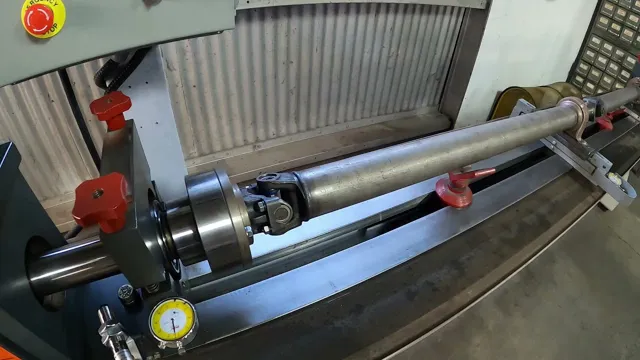
Benefits of Balancing Drive Shaft
Balancing drive shafts offers a range of benefits that many drivers are unaware of. Understanding imbalance is key to understanding why balancing drive shafts is so important. When a drive shaft is imbalanced, it can cause significant vibrations within the vehicle.
These vibrations can not only affect the smoothness of your ride, but they can also cause damage to other components of your vehicle. Balancing your drive shaft can reduce these vibrations, leading to a more comfortable ride and increased longevity of your vehicle’s parts. A balanced drive shaft ensures that the power from the engine is being delivered smoothly to the wheels, resulting in better performance and fuel efficiency.
By investing in drive shaft balancing at the first sign of trouble, you can avoid more costly repairs in the future and ensure that your vehicle runs smoothly and efficiently for years to come.
Preparation for Balancing
“Balancing your drive shaft is crucial to ensuring optimal performance and prolonging the life of your vehicle. Before you begin the balancing process, it is important to prepare by gathering the necessary tools and ensuring that the driveshaft is clean and free of any debris. This will help to ensure that the balancing process is accurate and effective.
Additionally, it is important to inspect the drive shaft for any signs of wear or damage that could affect its balance. If any issues are found, it is recommended that the drive shaft be repaired or replaced before attempting to balance it. Once you have prepared your drive shaft, you can begin the balancing process by either taking it to a professional mechanic or using a balancing machine.
With proper preparation and careful attention to detail, you can ensure that your drive shaft is balanced properly, allowing your vehicle to run smoothly and efficiently for years to come.”
Materials Needed
If you’re preparing to balance something, you’ll need a few materials to get started. First and foremost, you’ll need the item you’re planning to balance. If it’s a smaller item like a toy or a piece of jewelry, you might need a pair of tweezers or a steady hand to hold it in place.
For larger items like furniture or machinery, you might need a stable platform or a set of blocks to prop it up securely. In addition to the item itself, you’ll also need a level to ensure that it’s properly balanced. A bubble level is a simple and easy-to-use tool that can help you determine whether an object is level or not.
Finally, if you’re balancing something that’s heavy or unwieldy, you might want to consider wearing protective gear such as gloves or safety goggles to keep yourself safe. With these materials on hand, you’ll be well-prepared to balance your item with precision and accuracy.
Safety Precautions
When it comes to preparing for balancing, safety should always be your top priority. Before attempting any balancing tricks, ensure that you are wearing the proper safety gear, including a helmet, knee pads, and elbow pads. It’s also essential to warm up properly to prevent any muscle strains or sprains.
Make sure you have a good grip on the balance board and that the surface you are using is clean and dry to avoid slipping. Start by practicing basic balancing exercises and gradually work your way up to more advanced tricks. It’s also a good idea to have someone there to spot you as you practice.
By taking these safety precautions, you can minimize the risk of injury and enjoy all the benefits that come with balancing, such as improving your balance, core strength, and overall stability. Remember, safety first, fun second!
Balancing the Drive Shaft
If you’re experiencing vibration or roughness in your vehicle, it could be due to an unbalanced drive shaft. Balancing the drive shaft is an essential maintenance procedure for any automobile, as it directly affects both the performance and the longevity of the vehicle. The process involves checking the weight distribution of the shaft and adjusting it by adding or removing weights as needed.
To balance the drive shaft, you need specialized equipment that can measure the vibration and rotation of the shaft and determine the necessary changes. If you’re unsure how to balance your drive shaft, it’s always best to seek the help of a professional mechanic who has experience in this area. By taking the time to balance your drive shaft, you will ensure that your vehicle runs smoothly and lasts longer, saving you time and money in the long run.
Remember, preventative maintenance is always cheaper than replacing broken parts!
Step-by-Step Guide
Balancing the drive shaft is an essential process that helps to distribute the weight equally, reducing vibrations, and ensuring your car operates smoothly while driving. Whether you’re a seasoned mechanic or a newbie, you can balance the drive shaft yourself quickly and easily. Firstly, you’ll need to identify any missing weights, which can cause vibrations – use a high-speed balancer to help you verify any issue.
After identifying the problem, you’ll need to locate weights to fix the problem, and you can achieve this by using lead-based weights or steel weights. Once you have the weights, you can attach them to the shaft by drilling a hole into the shaft and quickly hammering it down. Continue to check that the weights are equal or fix the weight difference accordingly.
Lastly, check your balancing by using a high-speed balancer again. Congratulations! You have successfully balanced your drive shaft, and your car is now ready for a smooth drive.
Common Mistakes to Avoid
One of the common mistakes when working with a drive shaft is not properly balancing it. Balancing the drive shaft is critical because an unbalanced shaft can cause vibration, which can lead to damage or failure of other components. When balancing, it’s important to use the correct equipment and follow the manufacturer’s instructions.
Failure to do so could result in an improperly balanced shaft, which can cause further damage. It’s also essential to ensure that the balance weights are evenly distributed to avoid any imbalances. Overall, balancing the drive shaft is a crucial step that should not be overlooked.
Testing for Balance
If you are looking to ensure a smooth ride in your vehicle, it is important to test and balance your drive shaft properly. The drive shaft connects the transmission to the rear differential and moves power from the engine to the wheels. A balanced drive shaft prevents vibrations and shaking from happening while driving at high speeds.
To balance a drive shaft, you will need to first remove it from the vehicle and take it to a professional shop. At the shop, they will use a machine to test for any imbalances and adjust the weight distribution as needed. It is important to make sure that the drive shaft is properly balanced before putting it back into the vehicle, as an unbalanced drive shaft can cause serious damage to the vehicle and potentially lead to accidents.
Overall, ensuring that your drive shaft is in good condition and balanced correctly can greatly improve the performance and safety of your vehicle.
How to Ensure Proper Balance
To ensure proper balance in a test, it’s essential to carefully design the testing plan upfront. One approach is to start by brainstorming potential sources of bias that might affect the results and then create a plan to mitigate those effects. Additionally, it’s vital to think about the types of data that will be collected and how the analysis will be performed.
One helpful technique is to use a randomized control group to reduce variation and increase the accuracy of the results. By doing so, you’ll be able to ensure that the test results are reliable and that any conclusions drawn from them are supported by the data. Ultimately, this will help you make better-informed decisions and achieve the desired outcomes.
Conclusion
In conclusion, balancing a drive shaft is like finding the perfect balance in life. You want everything to run smoothly, without any vibrations or wobbles. The key is to identify any inconsistencies and address them with precision and accuracy.
Just like how a well-balanced drive shaft improves the performance of your vehicle, finding your own balance can improve your overall well-being. So, whether you’re balancing a drive shaft or your daily routine, remember to stay focused, stay level-headed, and stay balanced!”
FAQs
What is a drive shaft and its purpose in a vehicle?
A drive shaft is a mechanical component that transfers torque from the transmission to the axles. Its purpose is to help rotate the wheels and propel the vehicle forward.
What are the signs of a bad drive shaft?
Signs of a bad drive shaft include vibrations while driving, clunking noises, difficulty turning or steering, and equipment failure.
How can I balance my drive shaft?
To balance a drive shaft, start by removing it from the vehicle and then mounting it onto a special machine designed for balance testing. Correct the balance by removing or adding weight to the shaft as necessary.
How often should I inspect my drive shaft for balance and wear?
It is recommended to have your drive shaft inspected for balance and wear every 12,000 to 15,000 miles or at the first sign of any issues. Regular maintenance and inspection can prevent costly repairs in the long run.


